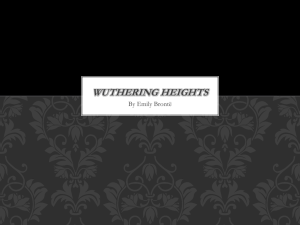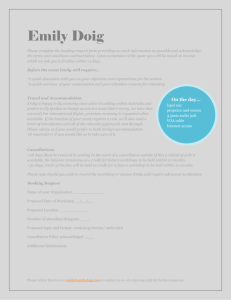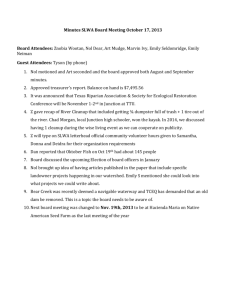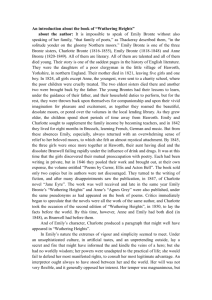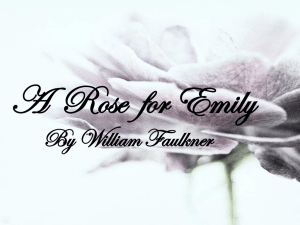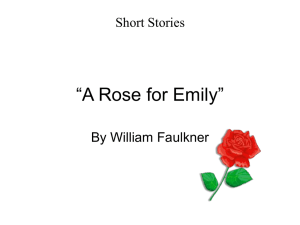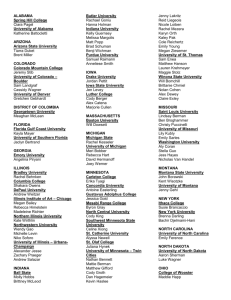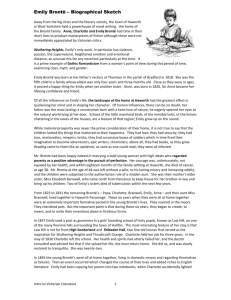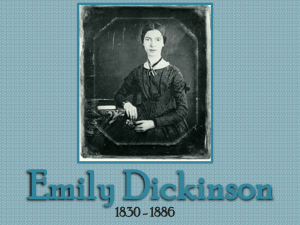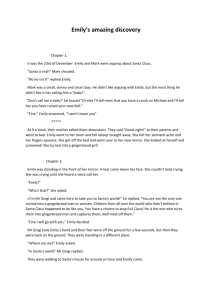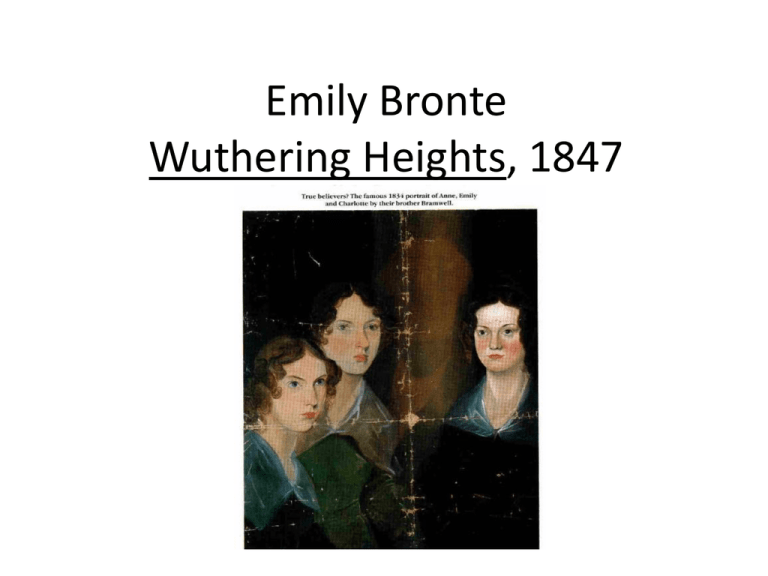
Emily Bronte
Wuthering Heights, 1847
•
•
•
•
•
•
•
•
•
•
•
•
•
What is Romanticism and (why) is WH a
Romantic text? What is the position of WH in
relationship to Romanticism?
Importance of individual and individual’s
creative talent
Subjectivity (visionary, non-rational sense)
Quasi-religious symbolic language
Value of nature in reaction to
industrialisation and urbanisation
Challenge to conventional morality;
personally liberalising ethical codes
Existing social order questioned
Politically radical
Emotions valued more highly than rationality
Admired innocence; accompanying senses of
wonder, alienation, terror , madness
Altered states of consciousness
Heroic figures and heroic deeds
National past discovered/fabricated –
exoticism and heroism
Rebellious anti-heroes sought out, invented
or re-interpreted
Sorting out the story
Biography: Myth and Truth
• CB: insisted that Emily was an innocent,
“homebred country girl” who did not have full
control over her talents; the involuntary
creative process; see p.19 Stoneman
• Garnered respectability and sympathy
Historical Context
•
Change 1800-1850s
– Industrialisation – changes to working and middle classes
– Pop doubled in Brit to > 20 mill
– New canals; better roads; better steamships; 1840s: telegraph, penny post, pillar box,
photography = better communication
– National railways system (1815 – steam engine); 1837 London to Manchester et al
– 1829 police force
•
Post war depressions leading to national unrest and increased repression
–
–
–
–
–
–
–
–
Combination Acts 1799 and 1800
1811-1816 Luddite
Bread riots in East Anglia
1819 Peterloo (St Peter’s Field, Manchester – 400 wounded, 11 dead)
1832 Reform Act
1837 spread of police force out from London
1838 ‘The People’s Charter’: demanded male suffrage, secret voting, equal electoral
districts, payment of MPs
‘hungry forties’
Historical Context 2: Politics
• Brontes were Tories – had ruled almost
continuously since 1783; supported landed
interests; Corn Laws – protection for ag but
increased the price of a working class staple;
origin of word ‘breadwinner’
• Catholic Emancipation Act 1829 supported by
Brontes; but anti-Catholic
• 1851 Great Exhibition; Crystal Palace:
nationalism, empire, commercialism,
consumerism
Historical Context 3: Social structures
• Social class: benevolence from superiors and deference from inferiors
• 1801: 2/3 of pop rural; end of century: 2/3 of pop urban
• Haworth a small industrial area – wool; poor housing and sanitation for
workers; avg age of death 25
• Lower classes: meatless diet, no vote
– Mechanics institutes e.g. Keighley; Sunday school
– Charity schools
• Brontes: lower class in terms of money; middle class in terms of education
– Governess
• Paternalism – regarded by most upper classes as answer to inequality: JS
Mill, The Principles of Political Economy, 1848: points out ironically: ‘the
lot of the poor in all things which affect them collectively’ will be ‘
regulated for them, not by them’
Historical Context 4: Women
•
•
•
•
•
•
Women’s functions in society biologically determined: ideal domesticated middle
class wife; irrational, intuitive, emotional, natural maternal instinct with nurturing
abilities; lacked male characteristics
Non-existence of women in marriage in law: could not litigate; early 1830s no right
to children in event of separation; 1839 custody for children under 7; money of
wife became that of husband (unless prenup); divorce = act of parliament
1851 25, 000 governesses; avg salary £25-50
1850s Florence Nightingale: nursing given status suitable for middle class women
1840s 30 x no. Of governesses as dom servants
Mary Taylor to Charlotte:
– “I have seen some extracts from Shirley in which you talk of women working. And this first
duty, this great necessity you seem to think that some women may indulge in – if they give up
marriage and don't make themselves too disagreeable to the other sex. You are a coward and
a traitor. A woman who works is by that alone better than one who does not and a woman
who does not happen to be rich and who still earns no money and does not wish to do so, is
quilt of a great fault – almost a crime.”
•
True middle class women were without sexual feeling – medical opinion; guilt
Historical Context 5: Religion
• Patrick: Anglican; establishment
• Late C18th – Methodism- focus on individual
story and enthusiasm – emotional approach
• Tractarians – seen as close to RC
Historical Context 6: The Mind
• CB and EB depressive; EB possible anorexic
• Madness not a medical matter; seen as deviants (along with
paupers and criminals); v. Few asylums existed
• C18th madness = overthrow of reason by passion; treatment:
restraint
• C19th demand for state run asylums, supported by evangelicals (to
be saved) and doctors (some money to be made)
• Mid C19th – alienist (alienation of the mind)
• Early C18th: physiognomy and phrenology; mid C19th: mesmerism
• Women and mental disorder: nervous collapse, melancholia,
monomania: seen as a physical dysfunction of one part of the brain
resulting in a pathological obsession in an otherwise healthy mind;
moral insanity: patient seriously broached social rules
Historical Context 7: Empire
• Empire a commercial enterprise
• From England: guns, gunpowder, knives,
beads, mirrors, alcohol
• Slavery: ‘Am I not a man and a brother?’ abolition; JMW Turner, 1783, ‘The Slave Ship’
Reception
•
•
•
•
•
•
•
Monstrous (+ and – connotations); mesmerising power
Complaints against subject matter – violence, sex, morality – and language – coarse, rough, savage
Emily’s power recognised even in those reviews that found fault: “It is the unformed writing of a
giant’s hand; the ‘large utterance’ of a baby god.” (Sydney Dobell) – see pp. 14-15 in Stoneman
Once Ellis known to be Emily (confusion of lives and works of the Brontes through the Victn era) –
identification of Gothic features led to feminisation and therefore dismissal
Late C19th: “Its power is absolutely Titanic” George Barnet Smith, 1857 – myth of neglected genius
Mary F Robinson, Emily, 1883: continues myth of neglected genius; damaging effects of Branwell;
morally righteous especially in feminist context; “Charlotte’s image of Emily as rustic recluse was
refined by Robinson into a modern Joan of Arc: chaste, courageous, combative.” (Stoneman, p. 28);
greater focus on aesthetic achievement than moral questions
Mary Ward, late-Victn critic: “is a book of the later Romantic movement, betraying ... The Romantic
tendency to invent and delight in monsters, the exaltation du mis, which has been said to be the
secret of the whole Romantic revolt against classical models and restraints; the love of violence in
speech and action, the preference for the hideous in character and the abnormal in situation – of
all these there are abundant examples in Wuthering Heights.”
Poetry
• Poems by Currer, Ellis and Acton Bell, (1846)
• Poems thought to be referred to in WH
–
–
–
–
–
–
–
–
No coward soul is mine
The soft unclouded blue of air
I do not weep, I would not weep
I’ll not weep that tour art going to leave me
Anticipation
Remembrance
Well some may hate and some may scorn
Sleep brings no joy to me
‘To imagination’
•
When weary with the long day's care,
And earthly change from pain to pain,
And lost, and ready to despair,
Thy kind voice calls me back again:
Oh, my true friend! I am not lone,
While then canst speak with such a tone!
So hopeless is the world without;
The world within I doubly prize;
Thy world, where guile, and hate, and doubt,
And cold suspicion never rise;
Where thou, and I, and Liberty,
Have undisputed sovereignty.
What matters it, that all around
Danger, and guilt, and darkness lie,
If but within our bosom's bound
We hold a bright, untroubled sky,
Warm with ten thousand mingled rays
Of suns that know no winter days?
Reason, indeed, may oft complain
For Nature's sad reality,
And tell the suffering heart how vain
Its cherished dreams must always be;
And Truth may rudely trample down
The flowers of Fancy, newly-blown:
But thou art ever there, to bring
The hovering vision back, and breathe
New glories o'er the blighted spring,
And call a lovelier Life from Death.
And whisper, with a voice divine,
Of real worlds, as bright as thine.
I trust not to thy phantom bliss,
Yet, still, in evening's quiet hour,
With never-failing thankfulness,
I welcome thee, Benignant Power;
Sure solacer of human cares,
And sweeter hope, when hope despairs!
Literary Context
•
•
•
•
Read Wordsworth, Southey, Byron (p. 75-6 Ingham), Scott, Gothic novels
Emily’s poem ‘To imagination’
Diary papers reveal lack of distinction between real and imaginary worlds
Angria and Gondal
– Gondal Emily and Anne replaced hero with a heroine – Augusta Geraldine Almeda: attractive
and ruthless
•
•
•
Poetry more prized than prose; although Dickens increasing in popularity; seen as
moral
Increasing literacy; lending libraries and 3 vol. Format; role lending libraries in
censorship, guiding public taste
The standards applied to authors of either sex...The requirements are:
circumspection in handling anything even distantly related to religion; extreme
reticence in sexual matters which must be euphemistically treated; abstention
from too close an examination of the seamy side of life (violence, cruelty,
alcoholism, adultery, bigamy); and above all the inculcation of a moral lesson,
preferably by a display of poetic justice for the sinner.” (p. 89, Ingham)
Literary Context 2
• CB: Biographical Preface: Tenant was “an entire mistake” – a
defence of Anne’s character (at the expense of the book)
• CB asserted that Emily’s isolated life and reclusive nature meant
that she was ignorant of the human nature which was the stuff of
novels and had listened to old wives tales of ‘tragic and terrible
traits’ in ‘the secret annals of very rude vicinage’. In saying this
Charlotte apparently accepts the mistaken belief that Haworth was
a barbaric and remote place and implies that these tales fired
Emily’s vivid imagination and led her to create Heathcliff...Crucially
having ‘formed these beings, she did not know what she had done’.
Charlotte...search[es] for some moral role models in the text: ‘the
true benevolence’ of Nelly Dean and ‘the constancy and
tenderness’ of Edgar Linton.” (pp92-93 Ingham)
Literary Context 3
• ‘Wuthering Heights’ was hewn in a wild
workshop, with simple tools, out of homely
materials. The statuary found a granite block on
a solitary moor; gazing thereon, he saw how from
the crag might be elicited a head, savage, swart,
sinister; a form moulded with at least one
element of grandeur- power ...With time and
labour, the crag took human shape; and there it
stands, colossal, dark and frowning, half statue,
half rock: in the former sense, terrible and goblinlike; in the latter, almost beautiful (CB Letters, p.
93 Ingham)

